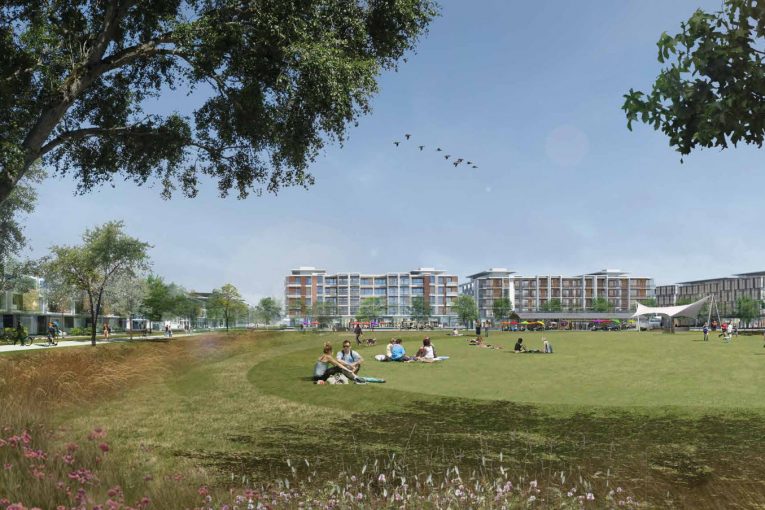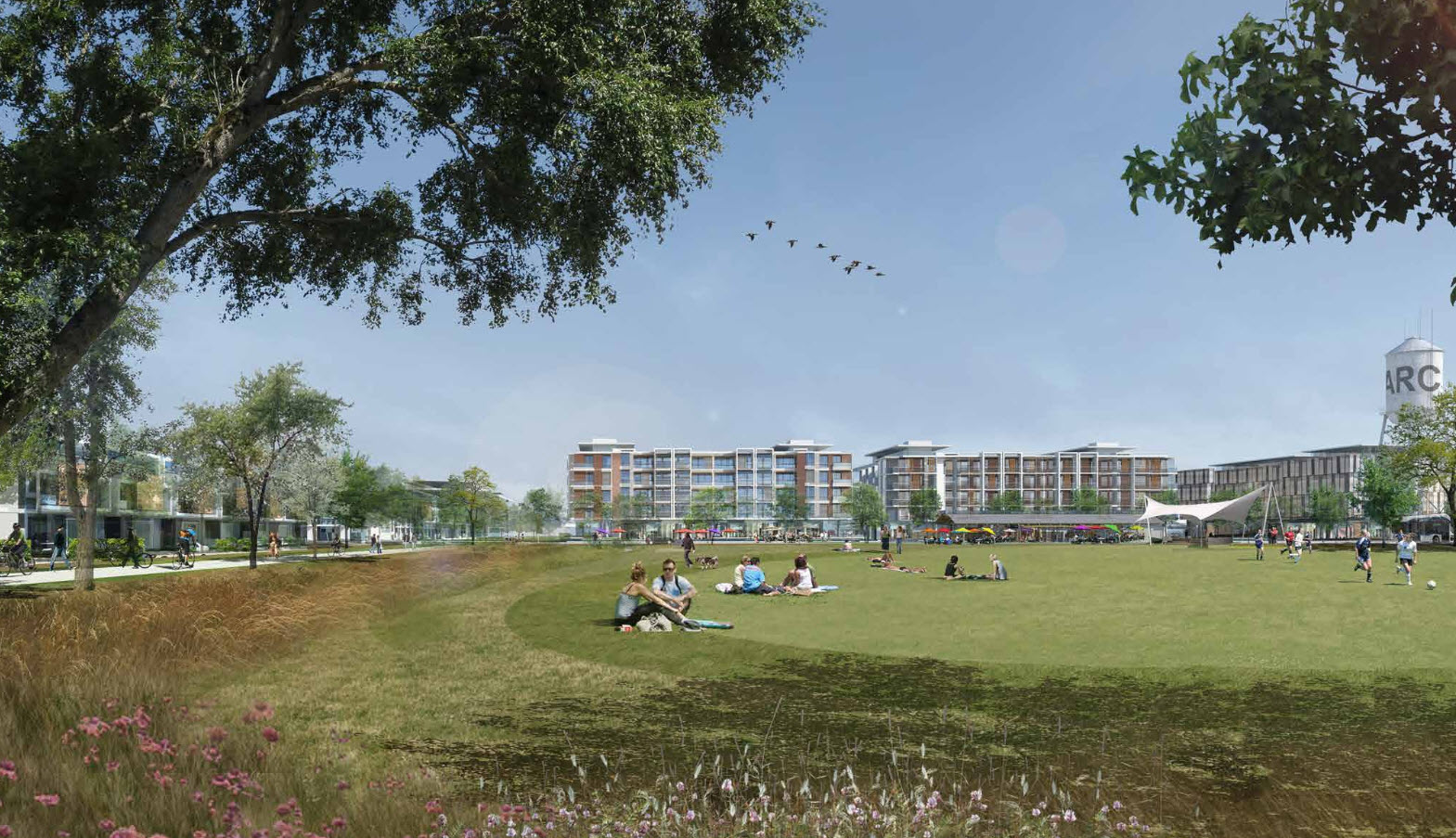

Last week the Social Services commission got to hear about the plan for affordable housing at ARC – perhaps less of a plan and more of a vague roadmap to a plan. I remain a strong supporter of the project – at least in concept – but I worry that the voters of Davis are going to demand a lot more in the way of specificity in affordable housing than they are getting.
The Social Services Commission did make one important modification to the plan. The applicant was asking the commission and the city to lock in the current Affordable Housing regulations in – this way they would have certainty when future designs for housing came forward and had to be approved by the city.
The commission itself was really divided on this, ultimately voting 4-3 to oppose the staff recommendation.
The concern was probably best articulated by Commissioner Don Kalman. He told his fellow commissioners, “One concern that I have is that currently I view our current ordinance for affordable housing as very weak.”
He added, “My concern is I think that by tying this to our current ordinance – I think that’s a big problem.” He said, “I’m not in favor of that. I don’t know what the answer is. But I definitely don’t want to tie this to our current ordinance.”
New Commissioner Kurt Snipes agreed, “I’ve come to feel that 15 percent isn’t enough and the amount of money the city is getting in lieu fees is not enough.” He added, “I’m very uncomfortable locking in something that I’m not even convinced is what we need now.”
All things being equal I would agree. The problem is that costs are such, getting a project to pencil out at even 15 percent has become a challenge. There doesn’t seem to be enough recognition  that the previous 35% was based on a world in which the state was kicking in huge amounts of money to subsidize the projects through redevelopment.
that the previous 35% was based on a world in which the state was kicking in huge amounts of money to subsidize the projects through redevelopment.
Mayor Brett Lee explained that redevelopment was where the state made available pretty sizable proportion of the funds that went to affordable housing.
“Unfortunately, roughly in 2012.. the redevelopment funds were taking away. What used to be there to supplement our fairly aggressive and robust affordable housing ordinance… those matching funds from the state disappeared,” the Mayor said. “Based upon the assumptions that the consultants have used, affordable housing is very difficult to provide at all at 15 percent, let alone at 35 percent.”
Thus in a post-RDA world, it seems hard to mandate more than 15 percent and in fact, the state is increasingly leery about going above 15 percent with requirements.
Brett Lee explained that in order to go above 15 percent, the city would be required to explain in great detail their justification. The problem as he explained, “have a high requirement means nothing got built” and he used the Merin County example of many communities that used the high measure to insure that nothing actually got built.
But what happens if the state implements a new tax increment for creating redevelopment or at least affordable housing? Given that some of the housing here might not be proposed or built for at least a decade, the Social Services’ commission had a good solution to the uncertainty – the project would be required to adhere to the Affordable Housing Ordinance at the time when the housing projects inside ARC are proposed rather than at the time of approval by the voters – if it is approved by the voters.
Still I think even this probably does not go far enough.
First of all, the idea by the commission should become the guide for the city. The city can probably justify the 15 percent requirement now – at a time when building costs are sky high and the state has abandoned redevelopment. But that is subject to change. Why not put into the interim ordinance a clause that requires affordable housing that is not built to reconsider their size and ratios if redevelopment or the increment tax comes back?
As far as ARC is concerned, the project needs to do more than it has on affordable housing.
Several points here are in order.
First, the voters of Davis have identified affordable housing and the lack thereof as the most important issue facing the city.
Second, the voters in polling have shown strong support for new housing and also the need for economic development.
Third, we saw what happened to Nishi in 2016 when they attempted to avoid on-site affordable housing and instead paid a relatively low in-lieu fee – that became a huge part of why the project lost even though, they had adhered to not only current city laws on vertical mixed use but state law at that time did not require affordable rental housing.
The applicants here need to keep the lessons of 2016 Nishi in mind – as the project was narrowly defeated despite the rising need for student housing.
The housing crisis is definitely an issue far more in focus today than 2016, but still, there are some concrete things that the developers can do to better ensure that their project meets the goal of providing more on-site housing for employees of ARC.
First, they need to ensure that housing is affordable for those working at ARC. Remember, a lot of these are going to be entry-level workers and so they are going to need both big “A” and small “A” affordable housing. Co-living and small scale studio apartments are likely going be most affordable for those workers.
As Matt Keasling, who presented for the applicants noted that the housing density is 30 units to the acre. “Our density range is 15 to 50 units to the acre, so these are a denser type,” he said noting that one-third would be townhomes as for sale and two-thirds as multi-family.
He added, “The type of housing that would be appealing to somebody working at this facility that is looking to have a close proximity to work, probably doesn’t need a car, not a lot of parking, not a lot of yard.”
Second, while the applicants are guarding against the unusual nature of this project, I think they can still do more than they have of specifying the type of affordable housing upfront.
“I know it’s not the story everyone wants in Davis,” Matt Keasling said where they want to hear, that they are building 300 units and to know how they are doing affordable housing. “That’s not this project. We’re building 2.6 million square feet of job creating space and with that 850 housing units at 30 units an acre.”
We get it – this is not a traditional housing project. It is not even really a housing project at all. Their main job is to build 2.6 million square feet of innovation space and the housing built here will serve that need.
Still, there is one clean way to deliver certainty here and that is to designate an adequate amount of land for affordable housing and then allow a non-profit developer come in and build that housing. Land is probably one the thing that they have most flexibility on. Then it’s just a matter of the non-profit developer raising the capital for the housing – but as we have seen, that’s a fairly straight forward process.
Even with uncertainty about the type of market-rate housing, nothing would prevent the developer from setting aside a few acres of land to put affordable housing on it.
If they want to make the case to the public that this is a project that will include housing that the employees of the ARC can afford, this seems like the surest path forward.
—David M. Greenwald reporting







Greenwald stated ”less of a plan and more of a vague roadmap to a plan.”
Ir’s not even that. It’s a scheme to try to avoid affordable housing. And the article does not mention another big part of the developer’s scheme presented at the meeting not even providing any affordable housing at all on-site.
This project is a boondoggle. There is not sufficient demand for the commercial/industrial uses, so they are tacking on hotel and housing to try to make it financially feasible. The developer is trying to hide that the amount of single-family housing has increased, as has the total amount of acreage of housing. And the amount of housing they are proposing is massive: larger than The Cannery for example.
Hide? How so?
Re: the “hiding”… In the summary tables produced by the developer’s attorney that the City posted on the project website, the developer claims that the single-family/multiple family housing breakdown is the same between the ARC “Mixed Use Alternative” and the new MRIC proposal. They are doing this because they have to say the project doesn’t have substantial changes in order to get a reduced environmental review process. But if you compare their site diagrams/maps, there is actually a huge increase in the single-family lots.
Likewise, the tables show show acreages of various land uses, but purposely omits an acreage comparison of the residential land. Looking at the diagrams, residential acreage is substantially higher in the MRIC proposal.
The tables done by the attorney also lie about a huge reduction in open space/park land far below City requirements, but that’s whole other story…
That is simply not true.
And is also the type of housing that would be appealing to somebody that doesn’t need much of a life, either.
Actually I lived in such places for 4-5 years. It’s what I (and spouse) could afford… so, when we had our first child, we found a SF house close to work (less than mile commute), good sized yard, and adequate parking for our two cars… yard became important when first child was born… one place was technically, a rental SF residence.
The house had been a “student rental”, so a bit of a fixer-upper…
We had a pretty good life, but were not “partiers”… still, it was ‘rich’…
Remind me not to bring you along as the color man on my comedy tour.
A lot of young people would like to live in affordable housing (subsidized or not) that they could walk to work. I think people need to give thought to who is likely to work for some of these emerging tech companies.
I think that the housing situation in Davis is bad enough that we need to just stop talking about affordable housing, and just talk about housing in general. If it’s housing, we need it.
If you want housing in Davis to be more affordable, we just need MORE of it. Supply and Demand are pretty simple concepts. The more we resist this very basic fact, the more we undermine our own local economy.
Another idea might be to not add more jobs than the community needs.
Adding more jobs than a community needs creates “artificial” demand for more housing, to borrow a term used by development activists.
The Bay Area provides a pretty good example of that.
Who decides how many jobs a community needs?
Existing commuting patterns (e.g., a net inflow of commuters) are a pretty good indicator.
That’s because UC Davis has thousands of jobs and most of the people can’t afford housing in Davis.
On the other hand, Davis has 21,000 people drive out of the city each day to work.
AND, UC Davis has one of the lowest retention rates in the country in terms of people graduating from UC Davis and staying here. That’s an indicator that the community needs more jobs especially since Davis also has one of the lowest bases for sales tax among both regional cities as well as among other university towns.
Much more complicated than your simple analysis. And you didn’t answer my question about who decides.
Well, the voters decide – regarding peripheral proposals.
So, you’re stating that you want to increase the number of inbound commuters, increase the price of housing (as a result of economic development), and increase pressure to approve even more sprawl. And, that new residents will pay the city’s pre-existing bills.
Good luck with that.
Saying nothing of the sort. Not even remotely correct. Show a total lack of understanding of how this stuff works.
Jumping in here, I have seen this point raised by you and others without really an appreciation that if Davis doesn’t create these jobs in this region, someone else will and they have the same issues. So the net impact on GHG is minimal at best. Moreover, Davis is likely to do more in the way of mitigation than Woodland or West Sac would.
Finally, I remember having this discussion years ago with Rob White and he made a point that really resonated with me – the economic development will be likely focused on agricultural technology – technology that can help feed starving people, technology that can help produce cleaner burning technologies that can reduce climate impacts across the world. Whatever local impact that we have from encroachment on farmland or in terms of traffic, will potentially be dwarfed by the benefit of such new technology.
Greenwald: Davis is very poorly situated on the edge of the SACOG region. The commute times into Davis are already some of the longest in the region, so adding more jobs here is likely much more detrimental in terms of GHG than in other areas of the region.
Why do you think the SACOG MTP calls for Davis to reduce its jobs-housing ratio?
On the other hand, Davis is well situated next to a major economic driver and a center for tech transfer.
Greenwald: you haven’t addressed the issue of Davis already being a net importer of commuters and regional plans to reduce GHG emissions to reduce the jobs-housing ratio in Davis.
Tim Keller stated ‘I think that the housing situation in Davis is bad enough that we need to just stop talking about affordable housing, and just talk about housing in general. If it’s housing, we need it.
If you want housing in Davis to be more affordable, we just need MORE of it. Supply and Demand are pretty simple concepts. The more we resist this very basic fact, the more we undermine our own local economy.”
You couldn’t be more wrong. Here’s how things work in the real world.
Why market-rate housing makes the crisis worse
https://48hills.org/2015/06/why-market-rate-housing-makes-the-crisis-worse/
Simply building housing without strong governmental invention to require affordable housing just exacerbates the problem.
Except of course that is not what the article says. Here is the pertinent quote:
They are talking about luxury construction, and they are looking at San Francisco, which is nothing like the market in Davis. Nice try.
Tim Keller has it right, we need to build more housing in Davis, period.
Mark West/ you chose to misinterpret and misrepresent that article. And you didn’t discuss the underlying research that is is based on.
I have links to dozens of other research articles that say the same thing. Tim Keller is providing a recipe for further exclusionary housing.
David: Your comments here are perhaps more forthright, than usual. I’ll go ahead and respond.
Those communities are (already) pursuing their own developments. There is no indication that a lack of this type of development in Davis will “shift” elsewhere. (It’s ALREADY shifted to Woodland, for example.) There is likely a limited market demand for it, or we wouldn’t be seeing existing commercial spaces “converted” to residential use. Nor would we see the “morphing” of the peripheral developments into residential proposals.
You previously “bemoaned” the loss of Schilling in a similar manner, which I understand is primarily focused on the gas/oil industry.
The proposed facility in Woodland is likely pursuing the same type of technologies that you are referring to, which calls into question the amount of overall market demand that the region can support. Also, as with the Schilling example, I have doubts as to the “purity” of such arguments. Not to mention companies that may use the same types of arguments such as Monsanto (and or those associated with GMOs/genetic engineering), etc.
And if you really want to discuss the world (at large) regarding ARC, you might want to consider what countries such as China are, or are not doing – for example.
Ultimately, one can only have influence locally. And even then, it’s tenuous and limited at best.
Overall, technologies which are in conflict with the earth itself can create bigger catastrophes, down-the-road (or sooner). We’re already seeing that with global warming.
Wow, there’s a lot of vague stuff in here that is pretty off the wall.
Schilling Robotics builds deepwater robotics. The oil and gas industry is part of their customer base, but not exclusively. “Today, our work class ROV’s are deployed throughout the globe operating in the oil and gas industry, renewable sector, military applications and deepwater research.” Any company focusing on robotics can readily pivot from oil and gas exploration to other applications.
Agricultural firms that work in the field of genetic engineering do not lack “purity” — although I’m unsure exactly what you mean by that term. If it’s in regard to climate change, genetic engineering is not increasing it. In all likelihood genetic modification of crops can be used to reduce inputs and directly or indirectly reduce the climate impact of the agricultural sector. They are exactly the sort of companies that Davis should be competing to attract, and presently they’re mostly going to Woodland or West Sac or Dixon. Davis would benefit from their presence in myriad ways.
Probably should start with David’s comments (to which I was responding) that ARC would essentially “save the world”.
Never said that it was “exclusive”, but what do you think the percentage of that industry is, for Schilling?
Well, the first article that popped up. Didn’t even read it, fully (but I recall the general issue):
If you’re “fine” with this, you have a different definition of “purity” and basic fairness, environmental protection, and public interest.
https://corpwatch.org/article/monsanto-bullies-small-farmers-over-planting-harvested-gmo-seeds
Should I go ahead and find some more articles regarding this issue?
No, because you clearly don’t read or analyze what you’re posting. Or, as you put it,
For the record, Monsanto’s patent on RoundUp Ready soybeans expired the year after that article was published. And Monsanto no longer exists.
I don’t feel like debating ag technology with you. I studied it and am in an industry that is tangentially agricultural, with considerable overlap with regard to labor, energy use, technology, and land use issues. The nursery industry is agricultural at the production end. Two of the larger grower nurseries have been located in the area, one formerly in Sacramento and one in Vacaville and Winters. Research is needed to make all ag-related businesses less polluting and more efficient in use of resources. That’s what these ag science firms do.
There are at least a dozen agricultural technology firms in the area, working on many crops. They are absolutely a natural fit for Davis due to the presence of UCD. They hire UC graduates in the field of ag research and development. It would be, and is, foolish to lose the benefits they provide locally.
Terrific. So, Monsanto’s seeds can contaminate organic seeds, and yet the ORGANIC FARMERS ARE THE ONES WHO COULD BE SUED!
Sounds completely ass-backwards, to me.
I believe this issue may have been covered on public television, as well. (Based upon vague memory – I could probably confirm, if needed.)
https://www.reuters.com/article/us-monsanto-organic-lawsuit/organic-growers-lose-decision-in-suit-versus-monsanto-over-seeds-idUSBRE9590ZD20130610
Ron, Monsanto no longer exists.
Oh, I missed the part that Don quoted regarding Schilling’s involvement in supporting “military applications”.
Yeah, I can see why you and David think that it’s a “terrible loss” for Davis and perhaps even the world. 😉
Just saw your quote (as I was typing this response) regarding Monsanto’s “non-existence”:
https://fortune.com/2018/05/29/bayer-monsanto-takeover-approval/
Anything else you’d like to discuss?
Perhaps the following quote, from the Fortune article above?
(Man, talk about “inserting one’s foot in one’s mouth”, or “quiting while one is behind”.)
By the way, is this the same “Bayer” that David (also) bemoaned, about the move to West Sacramento?
And, which moved there, due to what was essentially a “fire sale” regarding commercial rents?
That’s correct. Monsanto ceased to exist in June 2018. The product line and operations were absorbed by Bayer Corporation. There are lots of other ag businesses in the area. Are you opposed to all of them? Can you name any of them? Do you know what they do? Do you want to make a litmus test for which companies shall be allowed to locate within the city limits of Davis?
Yes it is. Ron, do you know anything at all about the businesses that exist in Yolo County? I’m mystified by this whole line of discussion you’re putting forth.
No. I object to statements (such as David’s, and others) which essentially suggest that such corporations exist to “save the world” (and as such, “belong” in Davis). When you start digging into what these companies actually do, it’s more of a mixed bag. And sometimes, darker elements aren’t very difficult to find.
Again, I’d suggest starting with David’s statement, to which I was initially responding.
Sort of… that would be an indicator of housing need.
Net outflow might be used as an indicator of jobs needs…
But, not that simple… you could have a situation where the jobs matched the professions/work positions of folk housed… little/no commuting… you could have the mismatch where the jobs of those housed are elsewhere, and the jobs locally were only filled by those coming from elsewhere… lots of commuting… the two extreme ends of the spectrum.
I have no access to, nor do I know if it has even been compiled, stats as to how many City employees live within the City… same for DJUSD… am pretty sure the %-ages of each have significantly declined in the last 40 years… a time frame I’ve experienced.
Two issues… housing costs, and salary compensation (in real/inflation adjusted dollars, for both).
Wouldn’t surprise me at all if that is true of UCD, as well.
It would indicate a “need” to avoid making the situation more challenging, by adding jobs in excess of what the community needs.
It might be used as an indicator to construct housing elsewhere – where the jobs are located.
Lots of theoretical “what if’s” posed, here. People commute all over the place, regardless. There is no indication that Davis has the “wrong” type of housing – other than possibly an inadequate percentage of Affordable housing, compared to market-rate housing.
On a more straightforward level, jobs at UCD combined with less-expensive housing nearby is already creating a net inflow of commuters.